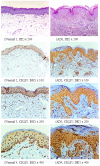Chemokine-like factor 1 (CLFK1) is over-expressed in patients with atopic dermatitis
- PMID: 23983609
- PMCID: PMC3753440
- DOI: 10.7150/ijbs.6291
Chemokine-like factor 1 (CLFK1) is over-expressed in patients with atopic dermatitis
Abstract
Background: Human chemokine-like factor 1 (CKLF1), a recently discovered chemokine, has a broad spectrum of biological functions in immune-mediated diseases. It is highly expressed on Th2 lymphocytes and is a functional ligand for human CCR4. CKLF1 has a major role in the recruitment and activation of leucocytes, which plays an important role in the pathogenesis of allergic diseases. The present study was designed to determine the expression of CKLF1 in skin and serum in patients with atopic dermatitis (AD).
Methods: The CKLF1 protein expression in skin lesion was analyzed by immunohistochemistry and ELISA. The mRNA expression of CKLF1 in skin lesion was detected by Real-time PCR. The serum levels of CKLF1, IgE, eotaxin, IL-4, IL-5, and IL-13 were measured by ELISA.
Results: Histopathological changes in the skin of AD patients showed local inflammation with epidermal thickening and significant inflammatory cellular infiltration. Immunohistochemistry results demonstrated that CKLF1-staining positive cells were located in the epidermal and dermis, and that the CKLF1 expression in AD patients was significantly higher than that in normal control. The CKLF1 mRNA expression in AD patients was significantly higher than that in healthy controls. Serum CKLF1 and IgE levels were significantly increased in AD patients, as were the serum levels of IL-4, IL-5, IL-13 and eotaxin.
Conclusions: Both CKLF1 protien and mRNA levels are overexpressed in the skin lesion of AD patients, along with an increase in serum CKLF1 level, indicating that CKLF1 may play an important role in the development of atopic dermatitis.
Keywords: atopic dermatitis (AD); chemokine-like factor 1 (CKLF1)..
Figures





Similar articles
-
Distinct expression of chemokine-like factor 1 in synovium of osteoarthritis, rheumatoid arthritis and ankylosing spondylitis.J Huazhong Univ Sci Technolog Med Sci. 2016 Feb;36(1):70-76. doi: 10.1007/s11596-016-1544-4. Epub 2016 Feb 3. J Huazhong Univ Sci Technolog Med Sci. 2016. PMID: 26838743
-
IMM-H004 therapy for permanent focal ischemic cerebral injury via CKLF1/CCR4-mediated NLRP3 inflammasome activation.Transl Res. 2019 Oct;212:36-53. doi: 10.1016/j.trsl.2019.05.007. Epub 2019 May 30. Transl Res. 2019. PMID: 31176667
-
Both Th2 and Th1 chemokines (TARC/CCL17, MDC/CCL22, and Mig/CXCL9) are elevated in sera from patients with atopic dermatitis.J Dermatol Sci. 2004 May;34(3):201-8. doi: 10.1016/j.jdermsci.2004.01.001. J Dermatol Sci. 2004. PMID: 15113590
-
CKLF1 in cardiovascular and cerebrovascular diseases.Int Immunopharmacol. 2024 Sep 30;139:112718. doi: 10.1016/j.intimp.2024.112718. Epub 2024 Jul 19. Int Immunopharmacol. 2024. PMID: 39032474 Review.
-
Role of chemokine-like factor 1 as an inflammatory marker in diseases.Front Immunol. 2023 Feb 14;14:1085154. doi: 10.3389/fimmu.2023.1085154. eCollection 2023. Front Immunol. 2023. PMID: 36865551 Free PMC article. Review.
Cited by
-
Dupilumab-associated head and neck dermatitis shows a pronounced type 22 immune signature mediated by oligoclonally expanded T cells.Nat Commun. 2024 Apr 2;15(1):2839. doi: 10.1038/s41467-024-46540-0. Nat Commun. 2024. PMID: 38565563 Free PMC article.
-
An Overlook to the Characteristics and Roles Played by Eotaxin Network in the Pathophysiology of Food Allergies: Allergic Asthma and Atopic Dermatitis.Inflammation. 2016 Jun;39(3):1253-67. doi: 10.1007/s10753-016-0303-9. Inflammation. 2016. PMID: 26861136 Review.
-
Identification of Prognostic Immune-Related Genes in Pancreatic Adenocarcinoma and Establishment of a Prognostic Nomogram: A Bioinformatic Study.Biomed Res Int. 2020 Jun 9;2020:1346045. doi: 10.1155/2020/1346045. eCollection 2020. Biomed Res Int. 2020. PMID: 32596278 Free PMC article.
-
Chemokine-Like Factor 1 (CKLF-1) is Overexpressed in Keloid Patients: A Potential Indicating Factor for Keloid-Predisposed Individuals.Medicine (Baltimore). 2016 Mar;95(11):e3082. doi: 10.1097/MD.0000000000003082. Medicine (Baltimore). 2016. PMID: 26986142 Free PMC article.
-
A genome landscape of SRSF3-regulated splicing events and gene expression in human osteosarcoma U2OS cells.Nucleic Acids Res. 2016 Feb 29;44(4):1854-70. doi: 10.1093/nar/gkv1500. Epub 2015 Dec 23. Nucleic Acids Res. 2016. PMID: 26704980 Free PMC article.
References
-
- Guttman-Yassky E, Nograles KE, Krueger JG. Contrasting pathogenesis of atopic dermatitis and psoriasis--part I: clinical and pathologic concepts. J Allergy Clin Immunol. 2011;127:1110–1118. - PubMed
-
- Wen HJ, Chen PC, Chiang TL. et al. Predicting risk for early infantile atopic dermatitis by hereditary and environmental factors. Br J Dermatol. 2009;161(5):1166–1172. - PubMed
-
- Willems LI, Ijzerman AP. Small molecule antagonists for chemokine CCR3 receptors. Med Res Rev. 2009;30:778–817. - PubMed
Publication types
MeSH terms
Substances
LinkOut - more resources
Full Text Sources
Other Literature Sources

